Frenchie Color Genetics
French Bulldog color genetics
One of the reasons French Bulldogs are so popular other than their, loving temperament, low maintenance and being the most supreme breed in the whole entire cosmos 😊 is because the wide verity of colors they can be produced in, well over 20. I’m going to explain these color genetics in a very introductory fashion. If you would like a more detailed and scientific explanation in regard to dog color genetics in general check out Animal Genetics.
http://www.animalgenetics.us/Canine/Canine-color/Color_Index.asp
First I would like to say if you don’t understand this at first don’t freak out, it took all of us some time to really get a grasp on this stuff. My recommendation is for you to read this though 3 or 4 times, get familiar with it all. Then come back the next day and really sit down and start pulling it all together. I also suggest sticking to this page before you go browsing animal genetic, its quite confusing and gives no explanation how all the traits tie into one another, which I do for you at the very end. Once you have read this a few times and really have taken the time to understand it I don’t mind if you message me on Instagram or Facebook if you have a question that may help clear all this stuff up.
A quick over view.
French Bulldogs have many colors and color patterns that when mixed together gets you the final color appearance of the dog. Each color and color pattern has its own compartment in the dogs coloring pallet called Locus (meaning Location), each Locus has room for 2 gene variants called Alleles. When these Locus are put together they end up giving you the final coat color of the Dog. Cocoa, Blue, Black, Cream, Fawn, variations of Brindle, Tan and Point and so on…. The lettering that you often see when someone’s trying to portray their specific dogs color DNA in letters is the Locus and Allele. You can look at it like this, a Locus and its Alleles for a blue dog looks like this (d/d). The little d’s are each its own Allele and the parenthesis that hold both Allele together is the Locus. The compartments or Locus are broken down as such: Blue, Cocoa, Testable Chocolate, Cream, Merle, Piebald all have their own locations. Ay(fawn)/At(tan and point)/a(solid black) and AW(sable) share another at the A-Locus. The next locations that shares a location with another Allele is the K-locus (known as the dominant black Locus) and here you have the Ky (allowing gene-more on this later) and the Kbr (brindle) gene.
When you see a big letter and or a little letter in the places where the Alleles are it is telling you if the dog is a carrier or a non-carrier of that specific color trait and a little letter means the dog IS a carrier of that specific color trait. Blue, Cocoa, Cream, AT, a, pied are all recessive genes meaning you need 2 copies to occupy a locus for the color to be expressed in a dogs coat. So blue would be (d/d) and cocoa would be (co/c0). If a dogs only carried 1 copy of the blue gene (D/d) the blue color won’t be expressed in the dogs coat. Merle and Brindle are dominate genes meaning you only need one copy of the gene in its specific location of it to be expressed in the dogs coat.
Below is a quick explanation for most of the Locus (locations) that are in the French Bulldogs coloring panel, that when put together gives your dog its final coat appearance.
K-Locus, also called the dominant black locus. Making Fawn and Brindle French bulldogs
If a dog is brindle it is determined at the K Locus(location). Two sets of Genes can be held here at this location, ‘Ky” and “Kbr”. The “Kbr” gene, also known as the brindle gene, is dominant over the “ky” gene. If a dog carries one copy of brindle it is showed as (kbr/ky) in the K-Locus or two copies(kbr/kbr). If the dog have 1 or 2 copies of the brindle gene the dog will express a brindle coat. The “Ky” gene, its known as the allowing gene. This is because when 2 copies are present it allows the A-Locus, the D-locus and B-locus to determine the dogs coat over all pattern. The “Kbr” brindle gene interferes with the color expression of the A,D and B-locus giving you the brindle look
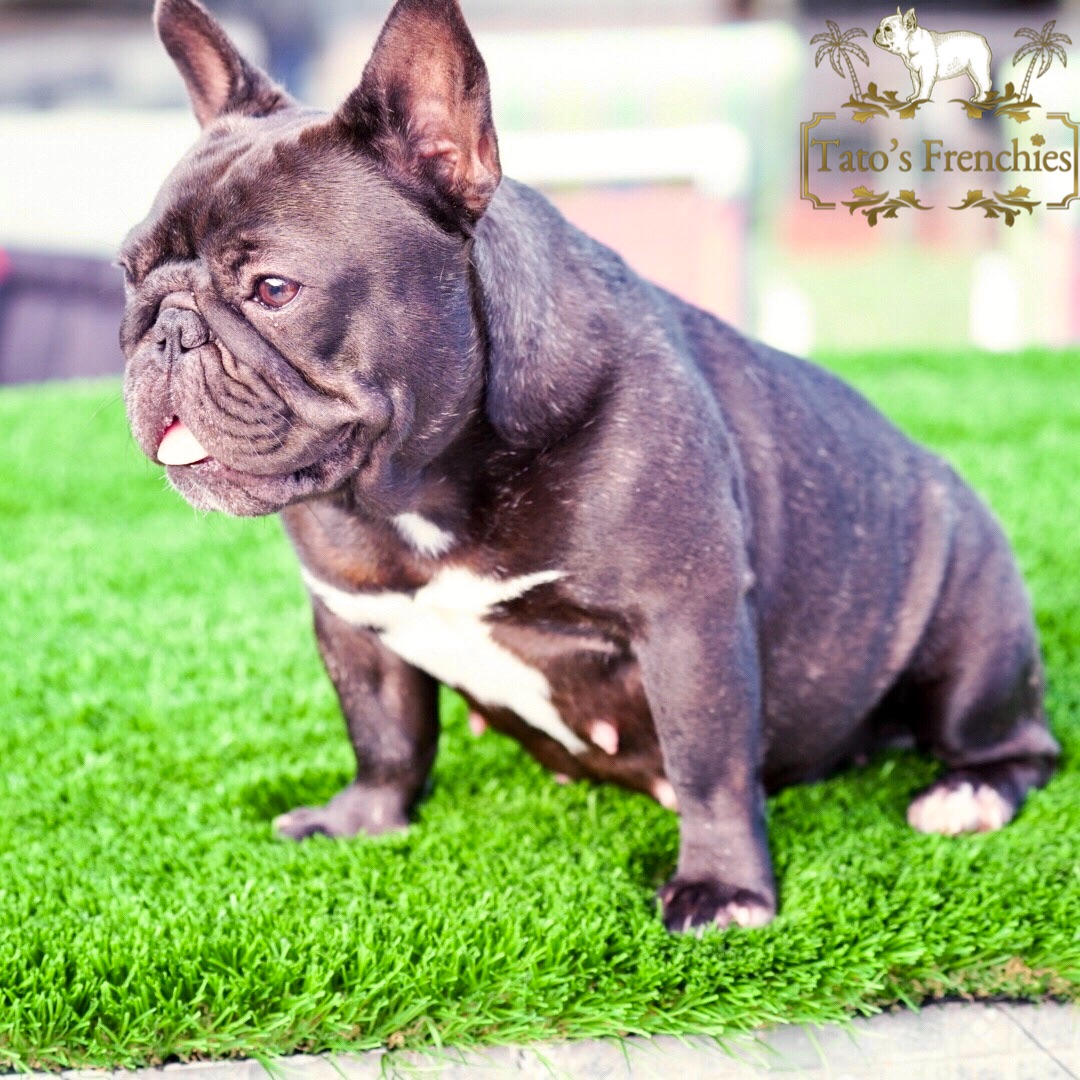
This is our Marlee, daughter of our Aikido and Scarlet. Since Scarlet is a fawn(ky/ky) and Aikido carries 2 brindle genes(kbr/kbr), Marlee and the whole litter she was born in were all brindle that carried fawn (Kbr/Ky). Since all puppies carry brindle and brindle is a dominant gene all puppies looked brindle. When Marlee is breed all her puppies will EACH have a 50% chance of being brindle and 50% of her litter can be fawn if she is breed to a Fawn dog (ky/ky).
A-Locus. Solid Black, Tri-color, Fawn and sable Locus gene here.
Boy is this Locus crowded! The four genes held at this location are “Ay” for Fawn, “At” the tan and point or Tri-color gene, “a” the solid black gene and “aw” for sable. “Ay” and “Aw” are very similar and are dominant over, “At” and “a”, making it so the tan and point or Tri-color gene “At” and the black gene “a” are not noticeable in the dog. “At” is dominant over “a”, so if a dog is (At/a) at this Locus the dog will show the same markings as a dog that’s (At/At). If a dog is (Ay/At)(Aw/At)(Aw/a) or (Ay/a) the dog will be fawn or sable not showing the traits from the tan and point gene of the solid black gene. A Dog will only be full solid black if its carries two copies of the “a” gene (a/a). A dog who’s brindle (kbr/kbr)( kbr/ky) will be brindle expressing itself over the A location. If a dog is (At/At) or (At/a) the brindling will be expressed where the tan points should be. If a dog is (Ay/At)(Aw/At)(Ay/a) or ( Aw/a) and carries 1 or 2 brindle genes the brindle will be expressed all over the dog. If a dog is (a/a) and carries 1 or 2 brindle gene the brindle is not expressed because since (a/a) is solid black and brindle is black that allows some fawn to come though there is no fawn to let though so the brindle is not noticed. If the dog is Ky/Ky not carrying a brindle gene it allows all genes in the A location to be expressed with our any interference.
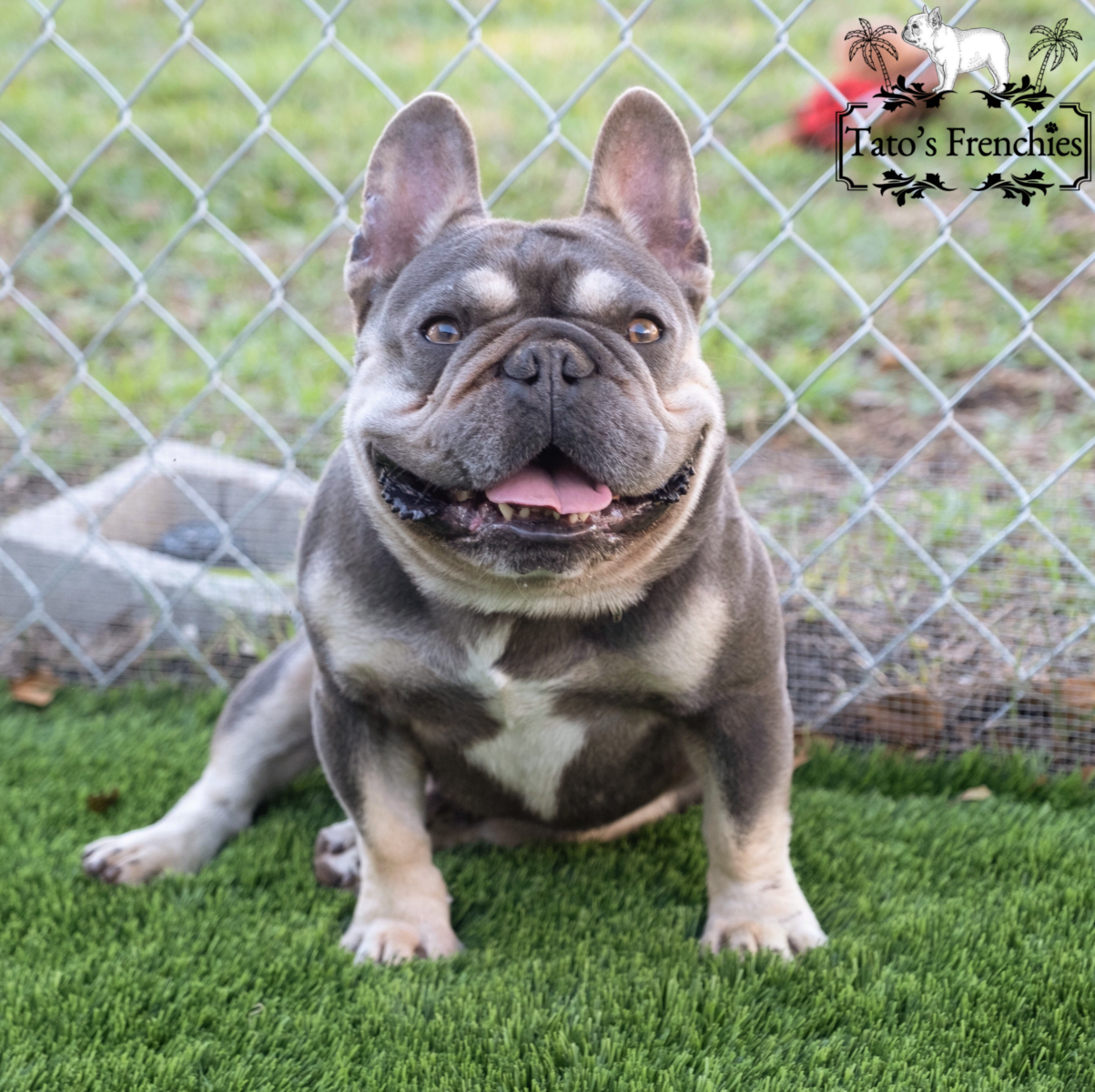
Our Napoleon is (At/a) at the A-Locus. “At” is the tri color gene and the “a” gene is the solid color gene. Since “At” is dominant over “a” the fawn tan points are allowed to be expressed. Even if he was (At/At) at the A-Locus his tan points would look exactly the same.
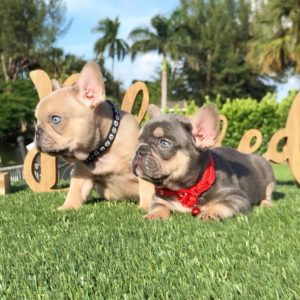
Here is another great example. Here are 2 puppies from one of Ocarinas previous litters. To the left you have a Lilac Fawn whos A-locus is (Ay/At), because “ay” fawn is dominant over “At” no solid color is allowed to be expressed. To the right you have a Lilac and Tan female whos A-Locus is (At/At), because of this her Tan points are totally visible.

Solid (a/a) with no brindle (ky/ky) dogs are pretty rare and in my opinion the most beautiful coats the French Bulldog breed has to offer. This is a puppy we called Velvet that’s a solid blue (d/d)(a/a). Velvets mom is (a/a) at the A locus(dominant black) she could only give her puppy an (a) gene(solid black). Napoleon is (AT/a), so in this case he gave Velvet his (a) gene making her (a/a). If Napoleon gave her his (AT) gene she would of been (At/a) and been a blue and tan and not solid blue
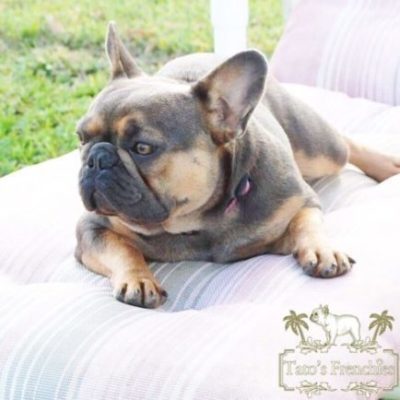
Our Ocarina is a Blue Sable (coc0Bbawat). Sables have a verity of coat types some more pronounced then others. The Sable doesn’t allow the “At” solid aspect of her coat to fully be expressed, this is why you see a blue coat on her competing with the fawn giving her that oaky color.
D-Locus. Blue French Bulldogs
The blue Locus seems to be everyone’s favorite. A fun fact about the D-Locus is actually just a dilute gene. It dilutes(waters down) the colors that the dogs are in the K-Locus and A-locus. If a dog is solid black with 2 blue dilutes its becomes a solid blue dog! If the dog is a Fawn dog with 2 blue dilutes it becomes a Blue Fawn, champagne color.
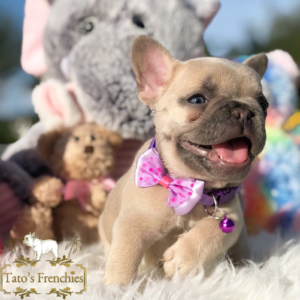
This girl is one of our previous puppies and is Blue Fawn(dd ayay). At the D-Locus she carries 2 blue dilute making her blue. At the A-Locus she is (ayay). At the K-Locus she is (kyky) allowing the D-Locus to dilute the A-Locus that is being allowed to express itself with out interference.

Our Azula(now retired) is (dd At/At Kbrky). At the K-Locus she carries 1 copy of “Kbr” the brindling gene, this covers up her tan points that you should see because shes (atat) at the A-Locus. If you look closely at her checks and paws you see a slight brindling because the “kbr” is covering the tan points. You dont see any brindling on the main part of her coat because the solid aspect of the “At” gene is dominant over “Kbr”. If a dog was (aa) at the A-Locus and carried brindle you would see zero brindling on their coat.
CO-Locus. Cocoa or Chocolate French Bulldogs
This Locus work similarly as the D-locus. The CO-locus needs 2 copies at the Cocoa gene in each of its Allele for the Cocoa color to be expressed. Cocoa is a testable gene just like all the others.
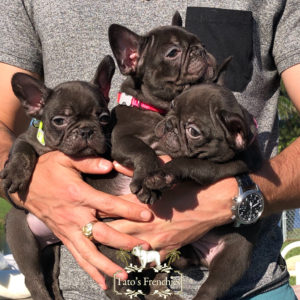
All these pups are from our Harmony(cocoDdata kbrky) and Max(DdCocoata kyky). 2 of these puppies are (cocoDdata kbrky) and one of them are (cocoDdaa kyky).
B-Locus. Testable Chocolate French Bulldogs
This Locus work similarly as the D-locus and CO-locus. The B-locus needs 2 copies at the testable chocolate gene in each of its Alleles for the testable color to be expressed. A French bulldog that is blue (d/d) and testable chocolate (b/b) is called and Isabella French Bulldog. A dog that is blue (d/d), Cocoa (co/co) and Testable Chocolate (b/b) is also called an Isabella French Bulldog. A dog that is Blue (d/d), Cocoa (b/b) and only carriers one or no copies of Testable chocolate is called a Lilac French Bulldog.
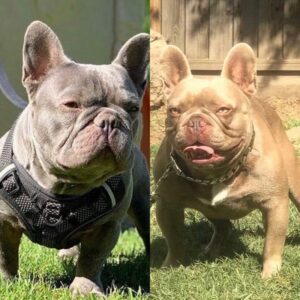
On the left is a solid lilac thats lilac is made out of 2 copies of cocoa and blue mixed together (co/co d/d a/a kyky). On the right is a solid Isabella thats has 2 copies Testable chocolate and Blue mixed together (b/b d/d aya kbrky).
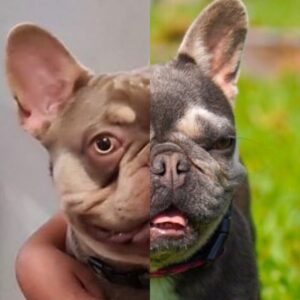
On the left is an Isabella and Tan made with 2 copies of testable chocolate (bb dd atat kyky). On the right is a Lilac and Tan made with 2 copies of Cocoa (coco dd atat kyky).
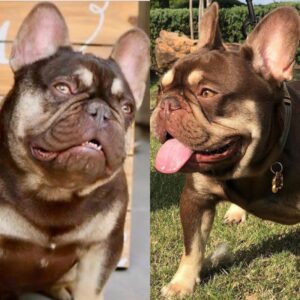
On the left is a chocolate and tan made out of 2 copies of Cocoa ( bb Dd ata kyky). On the right is a chocolate and tan made out of 2 copies of Testable Chocolate (coco Dd atat kyky).

On the left is an Isabella fawn (bb dd aya kyky). On the right is lilac fawn (coco bb aya kyky).
E-Locus. Cream French Bulldogs.
This Locus is called the Reverse yellow Locus but we know it as Cream : ) Cream is the most dominant gene is the Frenchie color pool if 2 copies are present in the Locus “e/e”. If a dog carries two copies of cream at the E-locus (e/e) the dog will be completely covered in cream no matter what color or pattern the dog carries. In most cases if a dog carries one copy of the cream gene (E/e) a slightly lighter coat can be noticed on whatever dominant color the dogs coat is. So, for example is a dog is Blue(d/d) and carries one copy of cream so its (d/d E/e) the dog will appear at times a little lighter blue compared to a dog that carries no cream. If a dog carries 2 copies of cream on a blue dog so it’s (d/d)(e/e), the dog will be completely covered in cream.
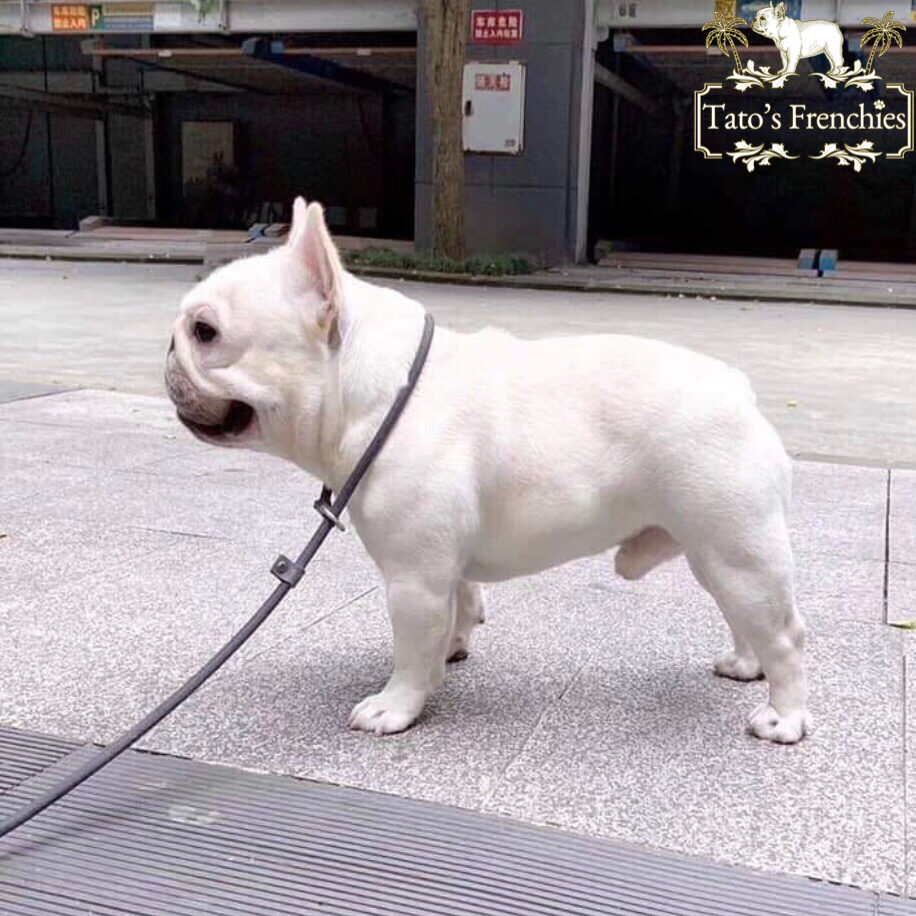
Here you have a cream dog that carries no other color except for bring cream and having 2 brindles ((e/e) (Kbr/kbr)). Since a dog being cream is dominant over brindle no brindle is being expressed.
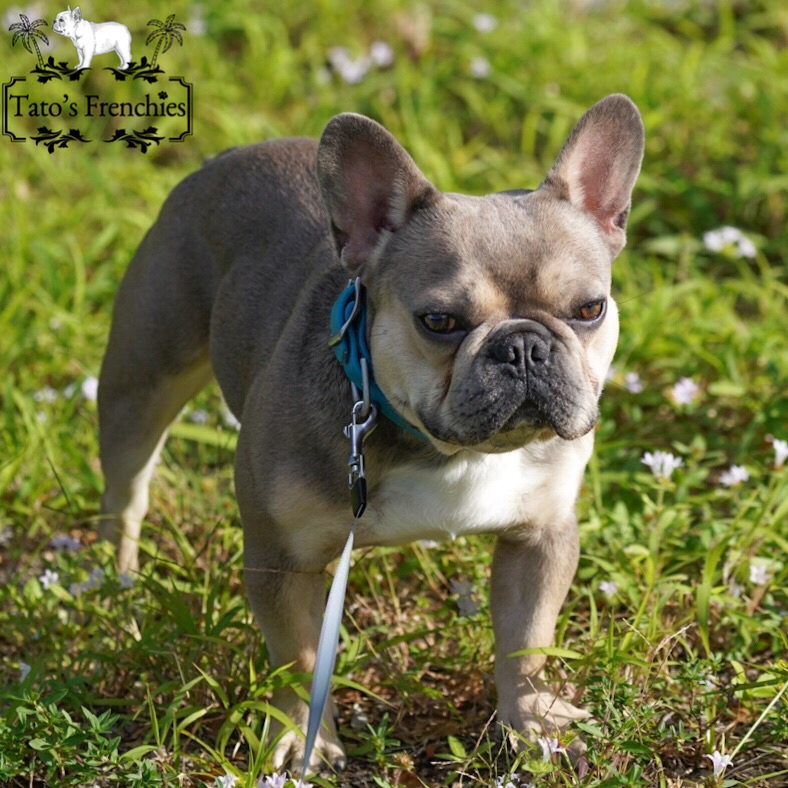
This is our baby boy Naz. He is a Blue Sable carry chocolate, cream, AT and one copy of pied. (ddBbayat Ee N/S). Since he only carries one copy of cream as you can see he is not all white.
Tri Color French Bulldogs
These are my personal favorite. There are many Tri color variations; Black and Tan, Chocolate and Tan, Blue and Tan, Lilac and Tan and Merle and Tans. What gives these dogs tan point markings is the Allele combination at the A-Locus. The “At” gene is the main component in giving the dog its tri-color appearance. As mentioned before the At gene is dominant over the “a” gene. So if a dog is (At/At) or (At/a) at the A-locus the dog will express its Tan Points. Apart from the dogs tan points what gives your dog its coat color is what Alleles your dogs carry at the D-Locus, B-Locus and M-Locus. The coat of a tri color dog that doesn’t carry 2 alleles of blue or chocolate base color is solid black.
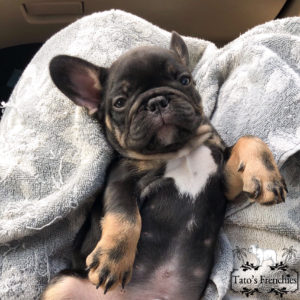
This is a clear pointed Chocolate and tan pup from Harmonies first litter. Hes (cocoDdatat kyky)
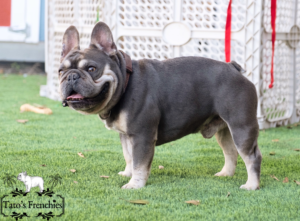
Napoleon is a clear pointed Blue and Tan that carries chocolate and cream. (ddCOcoata Ee)
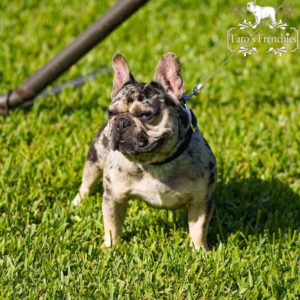
Our Max is a Black and tan Merle that carries chocolate and carries blue. (DdCOcoata kyky Mm)
Lilac French Bulldogs
This color is a combination of the D-locus(Blue) and the B-locus(chocolate) when 2 copies of each Allele are present at each Locus (d/d)(b/b). The coat will usually have a purplish color if the dog carries one or 2 copies of the “KBR”gene or be solid purple is the dog also is solid black to Tri color. (a/a)(at/a)(at/at). IF the dog isn’t Tri color, solid black (a/a) or carry the brindle gene the dog will be a lilac Fawn having a more yellowish champagne look towards it apposed to a blue fawn what would look snowier champagne.

This is Wolfie, Ocarinas Father. He was the first Lilac French Bulldog to land in America around 2012. He is a Lilac Fawn (ddbbayay kyky).
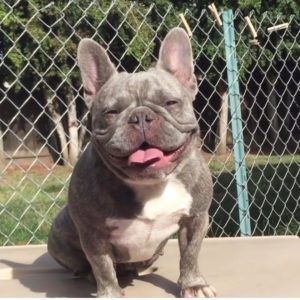
This is Harmonys mother, she is a Lilac trindle (ddbbayat kbrky). The only differences that makes her look different then Wolfie is that fact she carries 1 brindle gene in the K-Locus. This give hes that purple hue and noticeable brindling all over.
M-Locus Merle French bulldogs
The Merle gene is held at the M-Locus. A dog only needs to carry one copy of the Merle gene for it to be dominant and expressed on the French Bulldogs coat. It is not like the blue, chocolate, or cream Locus that need 2 copies the dilute for it to be expressed. So if a dog is blue and carries one copy of merle the dog will be a blue merle with merle pattern shown all over the French Bulldogs coat blue coat. When a dog is tan and point so (At/at) or( At/a) and carries no brindle gene the tan points are 100% visible on a merle dog. The Merle genes is lot more visible on a dog that has a dark coat such as brindle dogs (kbr/ky) or dogs that are tri color(at/at)(at/a) or solid black(a/a).

Our Max is a clear pointed Black and Tan Merle. (DdBbata kyky Mm).
S-Locus PieBald
The piebald gene is held at the S-Locus. It is a recessive gene so it needs 2 copies for the piebald to be expressed in the dog. For dogs that are dominate in Pied it is written as S/S. For dogs that are carriers of Pied it is written n/S. For dogs that are negative in Pied it is written as n/n.
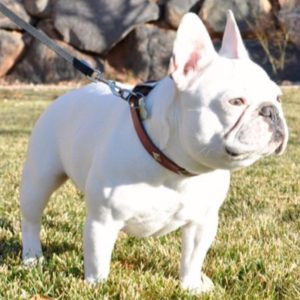
this is one of my favorite females and Napoleons mom. Her name is Belle and from Southern Utah French Bulldogs. (ddaya kyky s/s). She is a Blue Fawn carry “a” at the A-Locus and carries 2 copies of pied balled. Belle is called an extreme pieball because when dogs carry 2 copies of pied some time the pied covers a good potion of the dogs coat and in this case it covers everything making her extreme pied.
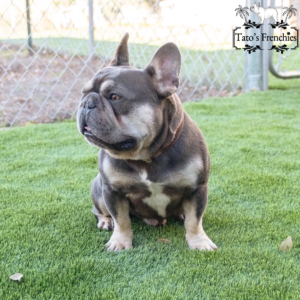
Napoleon (ddBbata kyky N/S) carries one copy of pied and because the S-Locus needs 2 copies of pied for it to be expressed on the dogs coat you don’t see any of the S-Locus expression.
Fluffy French Bulldogs
So obviously Fluffy French Bulldogs aren’t a color but let me quickly explain some things that I have been asked about.
- Fluffies need 2 copies of the Long hair trait in order for them to have long hair. If a puppy carries only one long hair trait it will be a normal short hair Frenchie.
- As far as colors, all colors can be created with with Fluffy Frenchie’s as can be made with short hair Frenchie’s.
- Fluffies long hair traits have different lengths when tested ex. L1, L2, L3, L4. Supposedly an L4L4 Frenchie will have longer hair then a L1L1 Fluffy however in my experience that is just not the case. Iv seen L1L1 Fluffies have just as long of hair as a L4L4 Frenchie. Furthermore you can breed an L1L1 fluffy with a L4L4 fluffy and all puppies with express long hair (L1L4).
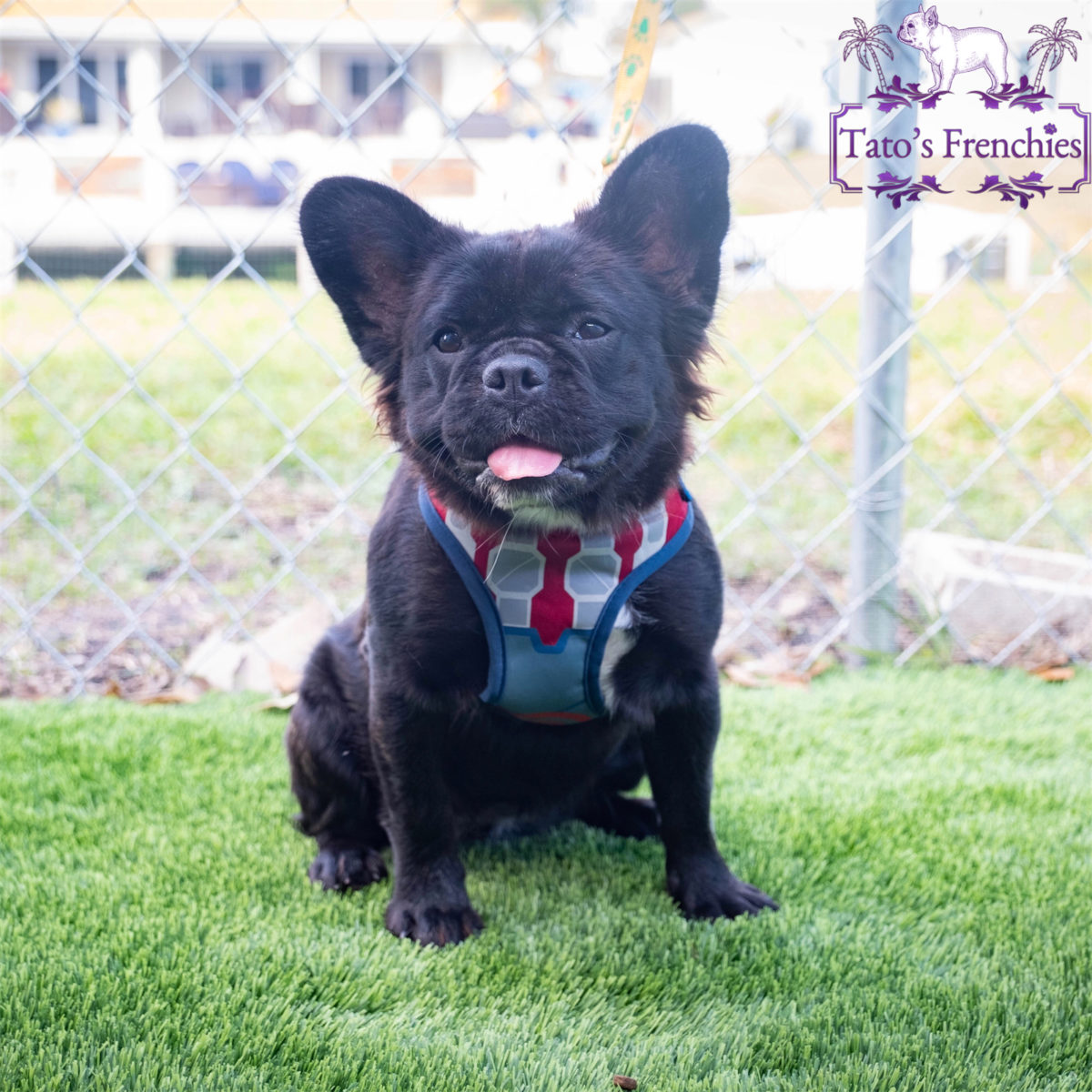
Here you have a full Fluffy Frenchie.
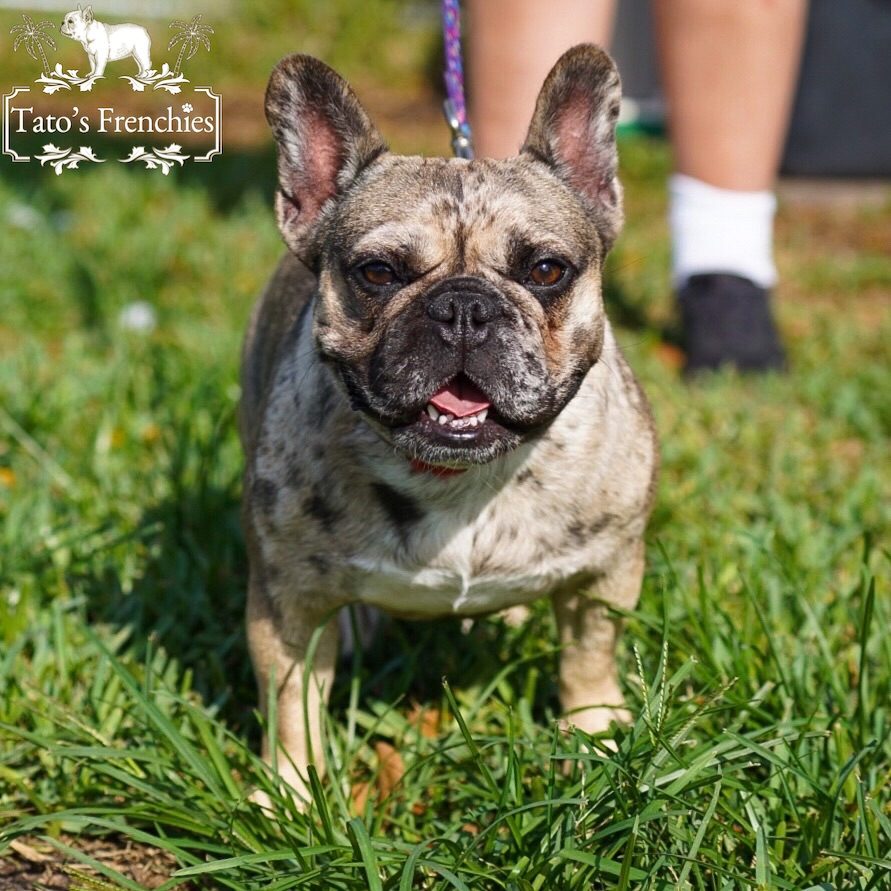
Here you have a short hair French Bulldog that only carries one copy of the Long hair trait do no long hair is expressed.
Lets get into how this all ties into each dog!!!!
Napoleon is a blue and tan quad carrier (ddCOcoata Ee n/s). We call him a quad carrier because he carries 4 color genes; Blue, Cocoa, Tri and Cream. He carries 2 copies of the blue dilute making his blue, 1 copy of the Cocoa gene at the Co-Locus, is (at/a) at the A-Locus making him a Tri(tan and point). He carries 1 cream gene (E/e) at the E-Locus making his a cream carrier and carries 1 copy of pie-balled (n/s). Since cocoa, cream and pie-balled are recessive you need 2 copies of them at there Locus for them to be expressed on his coat.

Max is a Black and Tan Merle triple carrier (DdCOcoata Mm). He carriers 1 copy of blue at the D-locus (D/d), 1 copy of Cocoa (CO/co) and is (at/a) at the A-locus. He also carries 1 copy of Merle at the M-Locus (M/m). Merle is a dominate gene meaning it only needs one copy of that gene at the M-Locus for the merle to be expressed. The tan and point expression (on their cheeks and legs) and a full cream(e/e) is the only place the merle pattern does not interfier. That’s why you only see the merle pattern on Max’s body and not his legs or cheeks. Blue and Cocoa are recessive they need 2 copies of the gene at each of their Locus to be expressed. Since he’s (at/a) at the A-Locus. “at” the tan and point gene and the “a” gene is the solid black gene. Since the tan and point gene “at”is dominate over the “a” gene the tan and point are expressed.
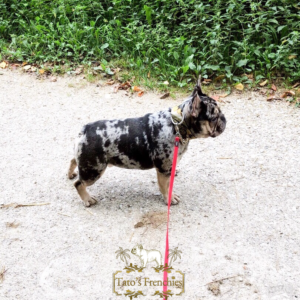
Ocarina is a blue sable carrying 1 cocoa gene at the Co-Locus and is (ay/AT) at the A-Locus. She would be written as d/d CO/co ay/at ky/ky. In the D-Locus (blue location) she is a double carrier making her blue. In the cocoa location she carries one copy of chocolate and since chocolate is a recessive gene it is not apparent in Ocarinas coat. At the A-Locus she is (ay/at), “ay” is dominant over “at” this is why she is still blue sable and not blue and tan with a sold coat. In some cases when a dog is sable and carry one “at” gene the tan points can be slightly visible. She carries no cream, no merle and no pied so in these locations it would be expressed (M/M)(E/E)(N/N) but when a dog doesn’t carry a certain color gene or pattern we do not show it when we write it out.

Azula is a brindle blue and tan also called a blue and tan trindle. This would be written as d/d CO/CO AT/AT kbr/ky. In the blue location she carries 2 copies of the blue dilute gene making her blue. She carries no cocoa gene making her B/B. Carries 2 copies of AT gene at the A-Locus(AT/AT) making her blue and tan. She carries 1 brindle gene (Kbr) that’s dominant over the AT/AT gene not letting azula express here Blue and tan markings. Where her Tan Point markings are suppose to be if you look closely you can see some brindling.
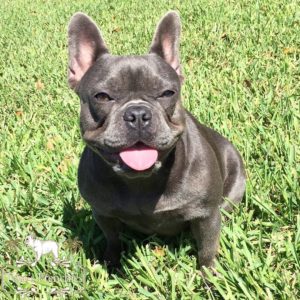
Harmony is a cocoa and tan brindle. Again in the Frenchie world she is known as a chocolate and tan trindle. She would be written as (co/co) (D/d) (at/a)( Kbr/ky). She carries 2 copies of the cocoa gene making her fur cocoa color. She carried one copy of the blue dilute gene and at the A-Locus she carries tan and point and the “a” gene (at/a). Then she carries one copy of the brindle gene (kbr/ky). Again because she carries the kbr gene and the kbr is dominant over the all Locus expect when a dog carries 2 cream genes at the E-Locus so harmony doesn’t express the tan and point.
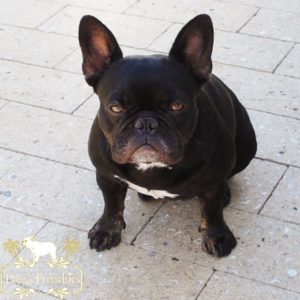
Text here
Now how this all applicable when it comes to breeding? Great questions! Let me get into it already!
When being bread every parent will give one gene from each Locus to its offspring (remember there are Locations in each Locus). So if a dog is a blue carrier and not a blue dog (D/d) its offspring will have a 50/50 chance of inheriting the Blue dilute gene or the empty Allele (D). If a parent carries 2 copies of the blue dilute gene like Ocarina and Napoleon, the puppies will 100% carry at least 1 dilute genes. For the offspring to carry 2 blue dilute genes it will be up to the other parent to give it to them. This goes for every Locus (color locations) the dog has.
Let me give you possibilities offspring possibilities from some pairings.
Napoleon is a Blue and Tans quad carrier (ddCOcoata E/e N/s) and Ocarina is a Blue Sable (ddCOcoayat n/n). At the D-Locus both parents are blue and carry 2 copies of the blue dilute gene so all their pups will carry 2 Blue dilute genes making all their dogs blue. At the Co-Locus (cocoa) both parents are cocoa carriers so they each have a 50% chance to pass it on to their offspring. So on average in a litter of 4 you will have 1 puppy that carries 2 copies of cocoa(co/co), 2 puppies that will carry chocolate (CO/co) and 1 puppy will not carry the cocoa gene (CO/CO). At the A-Locus Napoleon is (at/a) and Ocarina is (ay/at) so since Napoleon had a 50% chance of giving “at” or “a” to its offspring and Ocarina has a 50% chance of giving the “ay” or her “at” to her offspring these are all the possibilities for Napoleon and Ocarinas offspring at the A-Locus: (At/At)(Ay/At)(Ay/a)(Ay/At). Remember that (At/at) and (at/a) the dog will express tan and point. In the dogs that are (ay/a) or (ay/at) the dogs will be fawn. When its comes to the cream and pie-balled Napoleon carries 1 gene at each of their Locus and Ocarina does not. So for each of their offspring has a 50/50 chance of acquiring the pie-balled gene and the Cream gene at each of there Locus.
Below are 4 puppies from Ocarina and Napoleons previous litter together and the out come of there DNA.
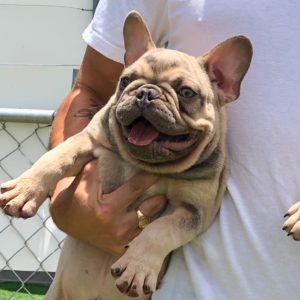
This boy is a Lilac quad (ddcocoaya Ee)
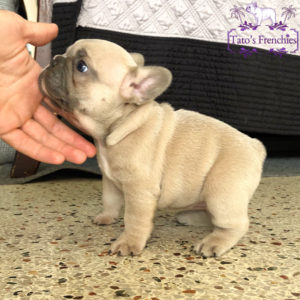
This girl is a Lilac Quad (ddcocoaya Ee)

This girl is a Blue fawn quad (ddCOco?aya Ee). There is a question mark for the cocoa locus because both Ocarina and Napoleon carry cocoa but since this girl is not a Lilac you cannot tell if she carries cocoa or not. Since both parents carry chocolate she has a 75% chance at carrying it. You can also look at is as she has 2 coin flips with a chance to carry the cocoa gene.

This girl is a Blue and Tan quad (ddCOco?ata Ee)
